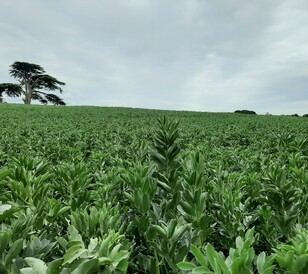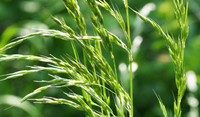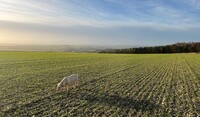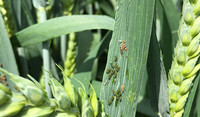Crop conditions and yield predictions…
Jonny Oosthuizen, Regional Agronomy Manager, South West
Holly Pratt, Regional Agronomy Manager, East
Jodie Littleford, Regional Agronomy Manager, North East
Will Nicholls, Regional Agronomy Manager, North and North Midlands
How are crops looking now that the majority of crop protection sprays have been made?
Jonny Oosthuizen, South West: In most places across the South West, there has been sufficient rainfall to reset crops onto a more “normal” growth path as opposed to rushing through stages owing to lack of moisture. In winter wheat, the majority of T3 applications have been completed or are currently taking place. Depending on the variety being grown, disease levels are mostly acceptable, with T3 sprays targeting fusarium, additional protection against septoria and potentially stamping out any rust. Spring barley crops are looking very clean, and either are, or will be receiving their T2 sprays very soon, with many growers choosing to include ARIZONA (500g/l folpet) to protect the all-important awns. Oilseed rape crops had been looking great until the mealy cabbage aphids moved in… hopefully, given the later infestation, the damage will be limited and yields will remain respectable.
Holly Pratt, East: Crops are looking very good in general. Some winter barley has already started to turn down in the South East, with winter wheat in flower and T3 sprays well underway if not already completed by the time of reading this. Yellow rust pressure has been high this year, with low to moderate pressure from septoria. The rain has been hit and miss in my region, but with most places receiving a decent amount of moisture more recently, crops are recovering from a dry spring. Sugar beet is, in most cases, meeting in the row, while oilseed rape crops are into the pod set phase.
Jodie Littleford, North East: Overall, the majority of barley crops in the North East are looking fantastic, although the recent rains have brought down a couple of fields of leggier crops. Oilseed rape has been podding up quite nicely and wheat is flowering with T3 sprays planned this last week. Fungicide programmes have been a bit more robust compared to last season so we’re waiting to see if that will hold the septoria down in the lower parts of the canopy given the recent damp weather. Mildew isn’t too difficult to find in thicker crops and there’s also still plenty of rust kicking about in susceptible varieties which may need monitoring.
Will Nicholls, North and North Midlands: Spring cereals seem to have caught up having had a drier start to establishment with barley awns poking through and spring wheat at the booting stage. All in all, disease levels across the board remain relatively confined to the lower canopy with timely fungicide applications between rain and gusts proving to be working well. Oilseed rape has also recovered following a hammering from pigeons earlier in the year, with plenty of pods and seeds ready for ripening over the next month.
Away from our usual focus, winter oats are also at the flowering stage and looking a bit more vulnerable to disease pressure in the upper canopy compared to wheat and barley. There’s a significant potential for crown rust to appear in the upper canopy, but recent cooler temperatures are currently keeping incidence low: this is a potential one to watch for in late June and into July depending on how the weather unfolds
When do you predict the first combine will roll in your region?
Jonny Oosthuizen, South West: This will vary between the extremes of the region, sowing dates and soil type. With the recent rains, what was predicted to be an early harvest may well return to a more normal timing. I expect to see the first combines working in OSR fields in early July followed by winter barley and then winter wheat from mid to late July. Of course, it also depends on the weather conditions at the time – just because crops are ready, doesn’t mean they’ll get cut!
Holly Pratt, East: Answering a question like that is surely going to jinx things, but I suspect that this year the combines will roll neither early or late. Crops seem to about where they ought to be for early June, so I see no reason why oilseed rape and barley crops shouldn’t be ready to harvest in July with wheats following soon after.
Jodie Littleford, North East: Combining in my region will, as always, be weather dependent: if we see a late hot spell then the crops may mature a bit earlier. My best guess on when the first combine will roll in the region would be 18th July.
Will Nicholls, North and North Midlands: With winter wheat crops in flower and barley awns displaying a golden-petrol tinge, it won’t be long before the eternal cry of “Who left the grease gun empty?” rings out across yards in preparation for what could be a slightly earlier start to harvest. Locally, I would estimate winter cereals are around a week ahead of schedule and looking full of potential. Whether this potential converts to yield will depend on how many sunshine hours we get between now and the end of the month, but we could see yields exceeding the yearly average, especially if the extra week gained allows for a few extra days of grain fill.
What are your yield predictions?
Jonny Oosthuizen, South West: I’m not brave enough to put a number on it, but speaking to numerous growers and agronomists across the region, I expect yields to be slightly better than average across the board. This could be considered optimistic in a year where many growers reduced their nitrogen applications, and we once again suffered a serious lack of moisture in the spring. However, compared to last season, it appears growing conditions have been more favourable and crops have responded well to inputs. That said, with crops having recently entered their final ‘production’ phase, grain fill depends on the all-important ratio of sunshine and rain throughout June and July. The proof of the pudding is in the eating, as they say!
Holly Pratt, East: As my dad would say, this year’s crops are “full of potential”. That’s certainly been helped by the little bit of rain we’ve had recently, along with plenty of sunshine and temperatures that aren’t too warm – the perfect conditions for grain fill. Let’s hope it continues!
Jodie Littleford, North East: Yield predictions are always difficult to make, especially as grain fill will be determined by the sunshine levels over the coming weeks. Given how well crops have looked throughout the season and the recent rains, I suspect we’re on course for some better than average yields. Barley in particular looks full of promise but equally the wheats have plenty of yield potential provided inputs have been considered carefully with little temptation to cut back. Oilseed rape can look like it’s going to yield well until the combine rolls through but the crop generally had a strong start and any additional yield here will be a welcome bonus to farm incomes. This may also sway a few more to return to the crop but as ever moisture will be a large determining factor. Whatever happens with the harvest results, we’ll soon be turning our attentions to the new growing season to start the whole process again…
Will Nicholls, North and North Midlands: As mentioned above, time – or more specifically what the weather does in the next few weeks – will determine how well or poorly crops in the North and North Midlands yield. There’s certainly some good potential as things currently stand, but I wouldn’t like to wager what the region’s final harvest results will look like. Suffice to say, we’ve all got our fingers and toes crossed for a positive outcome to another interesting growing cycle.



